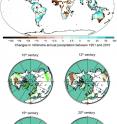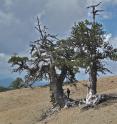Large variations in precipitation over the past millennium
Related images
(click to enlarge)
According to a new study in Nature, the Northern Hemisphere has experienced considerably larger variations in precipitation during the past twelve centuries than in the twentieth century. Researchers from Sweden, Germany, and Switzerland have found that climate models overestimated the increase in wet and dry extremes as temperatures increased during the twentieth century. The new results will enable us to improve the accuracy of climate models and to better predict future precipitation changes. Variations in decadal to centennial-scale drought and pluvial episodes - across the Northern Hemisphere - have been reliably reconstructed back to the ninth century for the first time.
"Now we can compare precipitation changes in various parts of Europe, Asia, and North America for the past twelve centuries. Precipitation anomalies have been stronger and covered larger areas in some earlier centuries than during the twentieth century", according to Fredrik Charpentier Ljungqvist, historian and climate researcher at Stockholm University and lead author of this study.
The researchers reconstructed changes in water availability by statistically analysing evidence for changes in precipitation and drought. To do this the researchers compiled hundreds of records of precipitation change across the Northern Hemisphere from archives including tree-rings, speleothems, lake sediments, and historical records. This is the first hemispheric-scale assessment of how a key societal resource - water availability - has fluctuated over the past twelve centuries.
To investigate the links between temperature and precipitation variations, the researchers compared their reconstructed precipitation variations with a temperature reconstruction which also was developed by the team. They conclude that it is possible to see clear correlations between variations in temperature and precipitation only in a few specific regions. For instance, during both the relatively warm twelfth century, and the relatively cold fifteenth century, drought was observed to be most widespread in the Northern Hemisphere.
"The study shows the importance of placing recent precipitation changes in a millennium-long perspective. Actual measurements of precipitation are too short to tell if the observed changes today fall outside the range of natural variability. Instrumental measurements are also too short to test the ability of state-of-the-art climate models to predict which regions of the hemisphere will get drier, or wetter, with global warming", says Charpentier Ljungqvist.
Both the climate model simulations and the updated temperature reconstructions agree that the twentieth century was likely the warmest in at least the past millennium. However, unlike the climate model simulations, the new precipitation reconstruction does not show an increase of wet and dry anomalies in the twentieth century compared to the natural variations of the past millennium. The precipitation reconstruction contains some uncertainties. Nevertheless the difference between the simulated and the reconstructed precipitation in the twentieth century is a robust feature and the reconstruction also agrees with meteorological measurements.
"The climate models simulate pre-industrial precipitation variability reasonably well but simulate much stronger wet and dry anomalies during the twentieth century than those found in the reconstruction. This does not necessarily mean the mechanisms driving precipitation changes in climate models are wrong. The explanation for this could be that the global warming is not yet strong enough to trigger the changes in precipitation patterns that climate models simulate", reports Charpentier Ljungqvist.
The temperature reconstruction presented, is in good agreement with the conclusions from the most recent report by the Intergovernmental Panel on Climate Change. Contrarily, the new precipitation reconstruction suggests that it is much harder to predict precipitation changes than previously thought. However, it is concluded that these new results can eventually improve the ability of climate models to better predict future precipitation changes.




